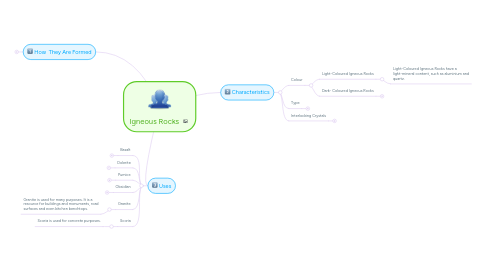
1. How They Are Formed
1.1. Volcanoes
1.1.1. Lava
1.1.2. Magma
1.1.2.1. Crystals
1.1.2.1.1. Crystals are made during the time lava or magma cools. Depending on how fast the molten rock cools is how large the crystals are. They are solid and are found in most igneous rocks.
1.1.2.2. Minerals
1.1.2.2.1. Physical Properties
1.1.2.2.2. Chemical Substances
2. Uses
2.1. Basalt
2.1.1. Basalt is usually used for building purposes such as bricks, floor tiles and concrete.
2.2. Dolerite
2.2.1. Dolerite is used for road surfaces and as concrete.
2.3. Pumice
2.3.1. Pumice is used for cleaning off dead skin because of its coarse texture.
2.4. Obsidian
2.4.1. Obsidian is used for jewellery and even surgical tools such as scalpels.
2.5. Granite
2.5.1. Granite is used for many purposes. It is a resource for buildings and monuments, road surfaces and even kitchen benchtops.
2.6. Scoria
2.6.1. Scoria is used for concrete purposes.
3. Characteristics
3.1. Colour
3.1.1. Light-Coloured Igneous Rocks
3.1.1.1. Light-Coloured Igneous Rocks have a light-mineral content, such as aluminium and quartz.
3.1.2. Dark- Coloured Igneous Rocks
3.1.2.1. Dark-Coloured Igneous Rocks have a high content in heav y minerals such as oliv ine and iron.
3.2. Type
3.2.1. Extrusive Igneous Rocks
3.2.1.1. Extrusive Igneous Rocks are molten rock (lava) that has cooled above the Earth's Surface. It has little crystals as it cools quicker above ground.
3.2.2. Intrusive Igneous Rocks
3.2.2.1. Intrusive Igneous Rocks are molten rock (magma) that has cooled below the Earth's Surface. It has more and larger crystals than Extrusive Igneous Rocks as it cools slower underground.
3.3. Interlocking Crystals
3.3.1. Interlocking Crystals are two or more crystals that have grown into each other.
